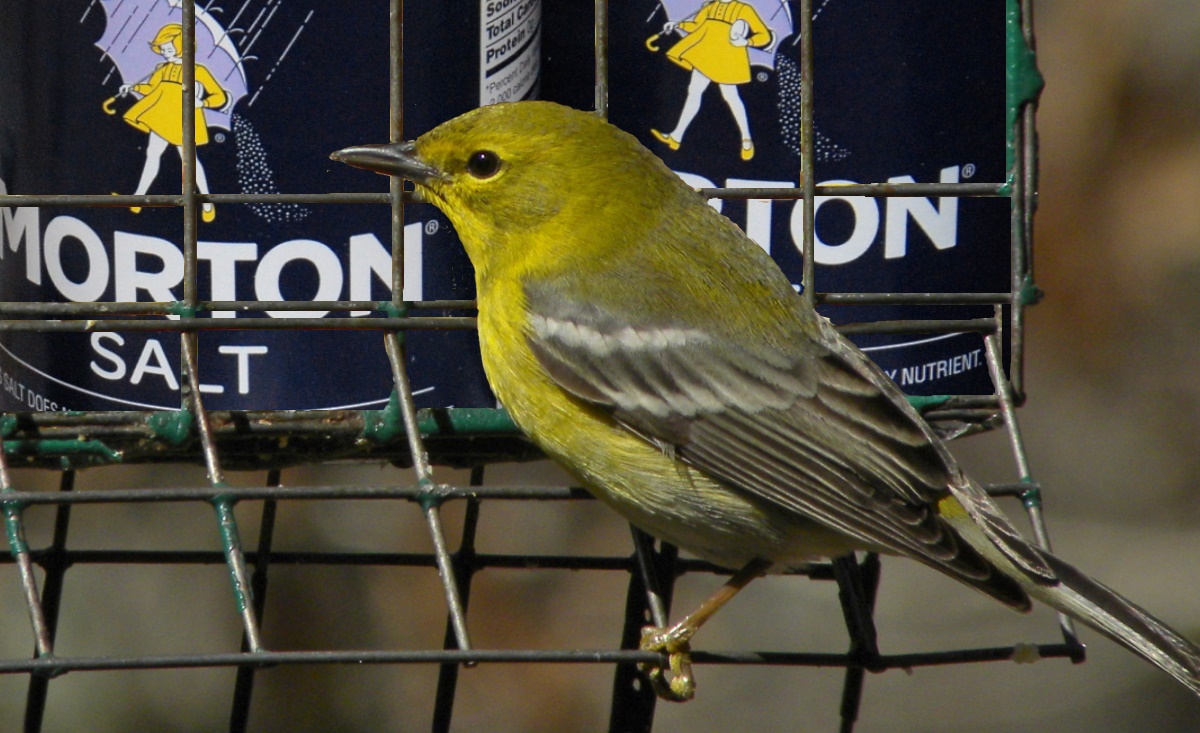
By Terry W. Johnson
Chances are if you made a health-related New Year's resolution, it probably involved vowing to eat less salt. The harmful effects of a high-salt diet on humans are well documented. But is the same true for the birds that visit our backyard feeders?
The truth is, despite widely circulated reports that salt will kill or harm wild birds, we really do not know for sure what, if any affect, salt has on them. Contrary to some of those widely circulated reports, anecdotal evidence suggests more than likely that salt does not pose a health risk for birds. In fact, they may face more danger flying to or feeding on salt, than from any risks posed by the salt they ingest.
Take for example, when salt is applied to highways during and after an ice or snowstorm. Vehicles kill untold numbers of wild birds that gather on and alongside the salt-treated pavement to eat the briny food supplement. This problem is more acute throughout the Midwest, Northeast and other areas where ice and snowstorms are regular events, prompting state and local highway departments to spread salt and other minerals on roads to make them safer for travel. In the Peach State, that scenario is played out most often in north Georgia.
The discovery of the fossilized bones of mammoths, musk oxen, giant beavers, mastodons and other extinct creatures at natural salt licks (also known as mineral licks) has revealed that for untold ages, wild animals have been visiting these salt licks. Knowing the sites attracted a wide variety of animals, Native Americans often hunted the creatures that congregated there.
Later, European colonists and settlers adopted the practice of hunting salt licks. Some of the licks, such as Blue Lick in Kentucky and Great Buffalo Lick in West Virginia, became famous. At times, communities were formed near mineral licks. A few, the Indiana cities of French Lick and Licking, for example, have retained their historic names.
But these licks were more than places where Native Americans and early settlers could easily obtain meat: They were also sources of salt needed to preserve food and tan hides.
Some of the licks were quite large. One in Ontario is approximately 100 feet in diameter. Often, salt licks take the form of a depression that collects water. The depression is created from wild animals eating the mineral-laden soil.
More than 40 years ago, I was shown a salt lick on Cedar Creek Wildlife Management Area near Eatonton. This manmade lick was created when salt blocks were annually placed there for a number of years. Over time, deer ate enough of the salty soil to form a depression large enough to hold a Volkswagen Beetle.
Nowadays Georgia deer hunters routinely create and replenish salt licks for white-tailed deer. This is done in the belief the minerals in a salt block will help bucks grow larger antlers and provide does with mineral supplements especially needed while they are feeding their fawns. As is the case with the salt licks provided by Mother Nature, manmade licks are also frequented by a variety of other animals such as rabbits, groundhogs, foxes, gray squirrels, chipmunks and birds.
Some birds definitely eat more salt than others do. Birds that are drawn to salt include purple finches, pine siskins, nuthatches, woodpeckers, blue jays and crows. So is the mourning dove. Realizing this, some unscrupulous hunters will scatter rock salt across fields in hopes of drawing flocks of doves within shooting range. This practice is considered baiting and is illegal in Georgia.
I have never seen anyone purposely offer salt to backyard birds. However, it has been reported that when folks have tried it, birds showed little interest in it.
When you come to think about it, we inadvertently offer salt to birds all the time. For example, salt is a major ingredient in the baked goods, peanut butter and a variety of the other cooked foods we feed to birds. Bacon grease is loaded with salt. And who hasn't fed salted nuts to birds?
As such, our own personal experiences suggest the salt contained in these foods is not killing the feathered diners at our backyard feeding stations.
If you want to see if birds are attracted to salt-laden soil, you might want to sprinkle some salt on a small bare spot in your yard. It will not take long for the salt to dissolve into the ground. Then, keep an eye on the spot and see if any birds eat the salty soil.
One word of caution: I do not recommend you try this in an area where deer are abundant. The last thing you want to do is attract white-tailed deer to your yard. Once there, they are likely to sample your shrubs, vegetables and prized flowers.
Whether or not you feed salt to the birds in your backyard is a personal decision. I don’t simply because there are so many items I can feed to birds that I am certain will not harm them, why would I feed them something that might even remotely case them problems?
I hope I have alleviated any fears you may have been harboring regarding the possible dangers of feeding salt to wild birds. In the meantime, if you have had an experience with birds eating salt, I would appreciate it if you would share it with me.
Terry W. Johnson is a former Nongame program manager with the Wildlife Resources Division and executive director of The Environmental Resources Network, or TERN, friends group of the division’s Nongame Conservation Section. (Permission is required to reprint this column.) Learn more about TERN, see previous “Out My Backdoor” columns, read Terry’s Backyard Wildlife Connection blog and check out his latest book, “A Journey of Discovery: Monroe County Outdoors.”